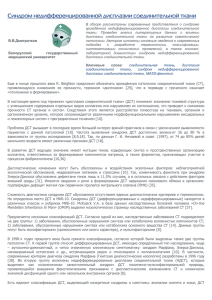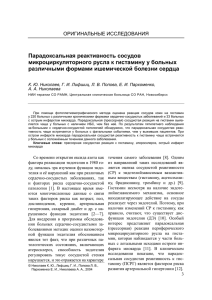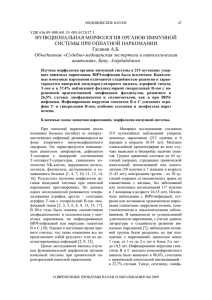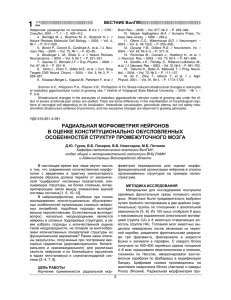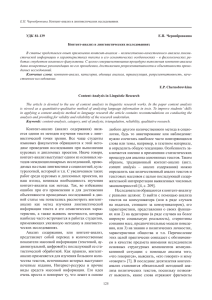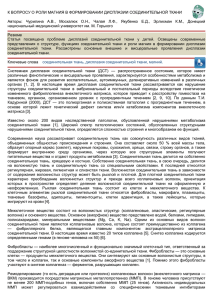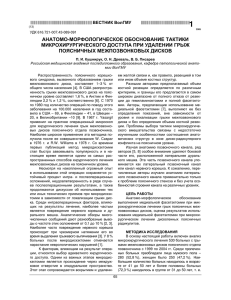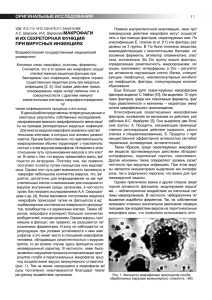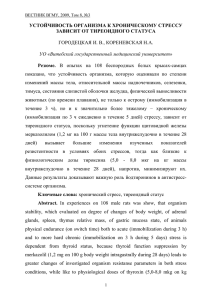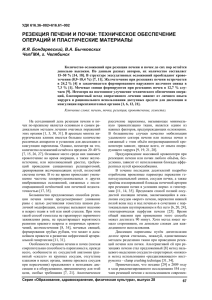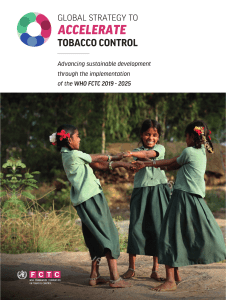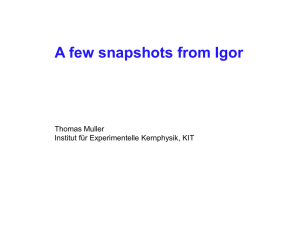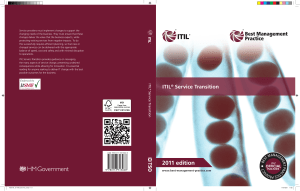INDUCTION OF SYSTEMIC ACQUIRED RESISTANCE OF PLANTS
advertisement
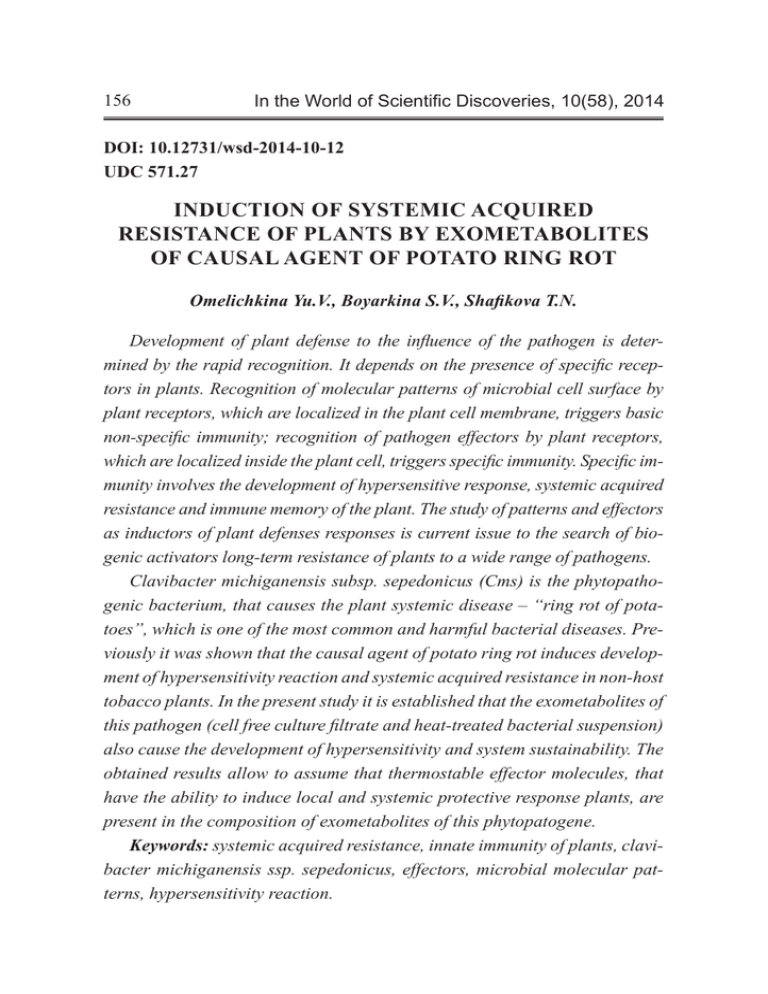
156 In the World of Scientific Discoveries, 10(58), 2014 DOI: 10.12731/wsd-2014-10-12 UDC 571.27 INDUCTION OF SYSTEMIC ACQUIRED RESISTANCE OF PLANTS BY EXOMETABOLITES OF CAUSAL AGENT OF POTATO RING ROT Omelichkina Yu.V., Boyarkina S.V., Shafikova T.N. Development of plant defense to the influence of the pathogen is determined by the rapid recognition. It depends on the presence of specific receptors in plants. Recognition of molecular patterns of microbial cell surface by plant receptors, which are localized in the plant cell membrane, triggers basic non-specific immunity; recognition of pathogen effectors by plant receptors, which are localized inside the plant cell, triggers specific immunity. Specific immunity involves the development of hypersensitive response, systemic acquired resistance and immune memory of the plant. The study of patterns and effectors as inductors of plant defenses responses is current issue to the search of biogenic activators long-term resistance of plants to a wide range of pathogens. Clavibacter michiganensis subsp. sepedonicus (Cms) is the phytopathogenic bacterium, that causes the plant systemic disease – “ring rot of potatoes”, which is one of the most common and harmful bacterial diseases. Previously it was shown that the causal agent of potato ring rot induces development of hypersensitivity reaction and systemic acquired resistance in non-host tobacco plants. In the present study it is established that the exometabolites of this pathogen (cell free culture filtrate and heat-treated bacterial suspension) also cause the development of hypersensitivity and system sustainability. The obtained results allow to assume that thermostable effector molecules, that have the ability to induce local and systemic protective response plants, are present in the composition of exometabolites of this phytopatogene. Keywords: systemic acquired resistance, innate immunity of plants, clavibacter michiganensis ssp. sepedonicus, effectors, microbial molecular patterns, hypersensitivity reaction. В мире научных открытий, № 10(58), 2014 157 ИНДУКЦИЯ СИСТЕМНОЙ ПРИОБРЕТЕННОЙ УСТОЙЧИВОСТИ РАСТЕНИЙ ЭКЗОМЕТАБОЛИТАМИ ВОЗБУДИТЕЛЯ КОЛЬЦЕВОЙ ГНИЛИ КАРТОФЕЛЯ Омеличкина Ю.В., Бояркина С.В., Шафикова Т.Н. Развитие защитных реакций растения на воздействие патогена определяется быстрым и адекватным его распознаванием, которое зависит от наличия у растения специфических рецепторов. При распознавании мембранными рецепторами растения консервативных микробных молекулярных паттернов активируется базовый неспецифический иммунитет; при распознавании цитоплазматическими рецепторами эффекторных молекул патогена запускается специфический иммунитет. Последний включает развитие реакции сверхчувствительности, системной устойчивости и иммунной памяти растения. Изучение паттернов и эффекторов в качестве индукторов защитных ответов растении актуально для поиска биогенных активаторов долговременной устойчивости растений к широкому кругу патогенов. Clavibacter michigaпeпsis subsp. sepedoпicus (Cms) – бактериальный фитопатоген, который вызывает у растения-хозяина системное заболевание – «кольцевую гниль картофеля», являющееся одним из наиболее распространенных и вредоносных бактериозов. Ранее было выявлено, что бактерии Cms индуцируют развитие реакции сверхчувствительности и системной приобретенной устойчивости у растения-нехозяина табака. В настоящей работе установлено, что экзометаболиты патогена – фильтрат, лишенный бактериальных клеток и термически инактивированная суспензия бактерий также вызывают развитие реакции сверхчувствительности и системной устойчивости. Полученные результаты позволяют полагать, что в составе экзометаболитов данного фитопатогена присутствуют термостабильные эффекторные молекулы, которые обладают спо- 158 In the World of Scientific Discoveries, 10(58), 2014 собностью индуцировать локальный и системный защитный ответ растения. Ключевые слова: системная приобретенная устойчивость; врожденный иммунитет растений; clavibacter michiganensis ssp. sepedonicus; эффекторы; микробные молекулярные паттерны; реакция сверхчувствительности. To survive in natural habitats under conditions of constant aggressive phytopathogenes action, a plant has innate immune system, it is ability to recognize a pathogen in due time and activate relevant protective mechanisms. Detection of pathogen is provided by membrane plant receptors, which recognize specific molecular ligands of microbe cell surface. These molecules were called microbial-associated molecular patterns (MAMP). Microbial patterns or MAMP are conservative molecular structures, which are characteristic of practically all microorganisms’ classes, regardless of their pathogenicity [1]. Detection of MAMP is performed by receptors called pattern recognition receptors (PRRs), which trigger immune signaling following activation by specific ligands [2]. This process results in activation of a number of protective responses leading to prevention of infection development. This immunity mechanism was called pattern-triggered immunity (РTI) [5] and presents the first non-specific level of plant innate immunity [3, 4]. During long-term joint evolution of plant and pathogen for suppression of the immunity of host plant pathogens developed the ability to secrete specific protein molecules – effectors (Avr-genes products), transporting them immediately to the cell through a universal type III secretion system. Effectors are delivered into the cytoplasm, bypassing the cell wall and plasmalemma and suppressed the development of PTI [5]. In the course of further joint evolution the necessity to survive resulted in emergence in plants of effector detection system. Emergence in plants of intracellular nucleotide-binding leucine-rich repeat (NB-LRR) proteins (R-genes products), which are able to recognize the effector and activate protective reactions leads to arising of the second specific level of immunity [6]. Following the NB-LRR receptor activation reactions В мире научных открытий, № 10(58), 2014 159 of effector-activated immunity including activation of WRKY transcription factors [7] and further molecular events, such as change in ion streams, reactive oxygen species (ROS) and nitrogen oxide accumulation, activation of PR-genes transcription for biosynthesis of salicylic and jasmonic acids, as well as ethylene [8, 9], result in triggering hypersensitivity response (HR), a form of programmed cell death (PCD) localized at the site of attempted pathogen invasion [10, 11] and accompanied by the development of non-specific systemic acquired resistance (SAR) plants to subsequent infection [12, 13]. Plant organism may also realize mechanisms of trans-generational immune memory, that is stress influence on one generation may bring about effective adaptation of the next generation to the same stress [14, 15]. Purpose The contemporary understanding of molecular-genetic mechanisms of plant-microbe interactions and relationships of different levels of innate immunity of plants has theoretical importance and practical value, since it leads to a new immunological approach to create preventive measures against plant diseases, consisting in the induction of its own immune forces of plant. It is allow giving up currently existing means of combating plant diseases, which often have a detrimental effect on both soil microbiocenoses and human health. In this context, the aim of this study was to study the ability exometabolites of causal agent of potato ring rot Clavibacter michiganensis ssp. sepedonicus (Cms) induce SAR in tobacco plants Nicotiana tabacum (L.). Materials and methods of research Bacterial strains and culture media. Clavibacter michiganensis ssp. sepedonicus (Cms) strain Ac1405 was obtained from the All-Russian Collection of Microorganisms (Pushino). Strain was routinely grown at 26°С in C medium, which contains per liter 5 g of glucose (“Reachim”, Russia), 10 g of peptone (“AppliChem”, Germany), 5 g of NaCl (“Reachim”, Russia) (рН 7,2) [16]. For preparation of the bacteria to be used in infiltration assays, cultures were cultivated to the logarithmic growth phase in a liquid medium at 26°C in 160 In the World of Scientific Discoveries, 10(58), 2014 the dark on a rotary shaker (130 rpm). To investigate the activity of Cms exometabolites, cell free culture filtrate (CF Cms) was prepared. The culture was filtered through a 0.2-µm membrane filter. This preparation was immediately used either for infiltration assays on tobacco plant leaves or for investigation of reactive oxygen species accumulation. Also in this assays we used heat-treated bacterial suspension (dead culture, DC Cms). Bacterial culture contained in Eppendorf tubes were heated to 100°C in boiling water bath for 15 min. To determine whether Cms induces of SAR development in tobacco plants we used Escherichia coli. E. coli strain XL-1Blue was routinely grown on meat-peptone agar (MPA) (“Obolensk”, Russia) at 26°С in the dark. For infiltration assays, the culture was grown stationary in meat-peptone broth (MPB) at 26°C in the dark. Plant Materials, Growth condition and inoculation procedures. Tobacco plants (Nicotiana tabacum L.) were grown in vitro in Murashige and Skoog (MS) medium [17] under greenhouse condition with light16-h / 8-h dark photoperiod at 24–25°С at day and 19–20°С at night, a light intensity of 5–6 кLx. Tobacco cultured cells were grown in the dark in MS medium. Subcultures were made weekly by tenfold dilution with fresh medium. For elicitation experiments 5-day cultures grown at 26°C on a rotary shaker at 130 rpm were used. This stage is corresponding to the second half of the logarithmic growth phase, which is characterized by the highest physiological activity of cells. To study the response of tobacco plants on the infection with the culture of Cms and its exometabolites we used infiltration assay. Tobacco plants were grown to three weeks. Plant leaves were infiltrated with 3 µl Cms (1×107 CFU/ml), CF Cms or DC Cms with sterile syringe. Also, infection of plants was carried out through the root system by introducing a bacterial suspension with a syringe into the culture medium. Medium C was used for infiltration assays as control. Inoculated tobacco plants were moved back to the grown chamber under the same conditions prior to inoculation and visually monitored for reactions. To determine SAR development tobacco plants, which pretreated by Cms, CF Cms or DC Cms, were infiltrated with 3 µl E. coli (1×108 CFU/ml) with sterile syringe after 7 days post priming. В мире научных открытий, № 10(58), 2014 161 Hydrogen peroxide measurements. To study such response reactions of the plant innate immunity as the accumulation of reactive oxygen species, the method of co-cultivation of tobacco cell cultures and bacterial suspensions was carried out. During co-cultivation, the formation of hydrogen peroxide plant cells was determined using a method based on the reduction reaction of a hydroperoxide with iron ions in the acid solution to form an iron complex with xylenol orange indicator [18]. Research results and their interpretation In our previous study, it was shown that inoculation of bacteria Cms into tobacco leaves induced a HR development and accompanied by SAR. Bacterial culture was also able to induced rapid cell death of cell-suspension culture of tobacco. Observed morphology changes in infected, cultured tobacco cells were in line with features of programmed cell death development. We have obtained that infected cultured cells showed response defensive reactions, such as the rapid generation of reactive oxygen species [19, 20]. Here we report that along with the bacterial suspension of Cms, cell free culture filtrate CF Cms as well as heat-treated dead culture DC Cms able to induce HR development at the site of infection (Fig. 1.). Fig. 1. A local reaction of tobacco plants at the site of infection Cms, CF Cms and DC Cms Similar results were found when cell free culture filtrate and dead culture were infiltrated into medium around roots of tobacco plant. Necrotic lesions HR formed on the roots of tobacco plants after infiltration bacteria, CF Cms and DC Cms (Fig. 2). 162 In the World of Scientific Discoveries, 10(58), 2014 It should be noted that the development of SAR is accompanied by development of protection long-term plant responses to a wide range of pathogens, including atypical pathogens for plants, for example, the causative agent of the disease in humans and animals E.coli [19]. It was shown, that local necrosis HR was induced at the site of E. coli infiltration on the plants pretreated by Cms, CF Cms or DC Cms (Fig. 2). Thus, not only Cms induces SAR development, but SAR-induced activity was found in cell free culture filtrate (CF Cms) and dead culture (DC Cms). Fig. 2. Necrotic lesions formed on the roots of tobacco plants after infiltration bacteria Cms, CF Cms and DC Cms; local necrosis formed at the site of E. coli infiltration on the plants pretreated by Cms, CF Cms or DC Cms It is known that pathogen infections induce a rapid accumulation of ROS in plant tissue, which is involved not only in limiting pathogen ingress, but in induction of cell death and in signal transduction of many defense processes. To investigate accumulation of ROS, co-cultivation of tobacco cells with Cms, cell free culture filtrate Cms or heat-treated dead culture Cms was performed. Time-course analyses using this systems showed, that content of apoplast forms of hydrogen peroxide increased rapidly during 1h after onset co-cultivation with not only bacterial cells, but also its metabolites (CF Cms) and heat-treated metabolites (DC Cms) (Fig. 3). These results clearly indicated that exometabolites of Cms is sufficient to activate immune responses. В мире научных открытий, № 10(58), 2014 163 Fig. 3. Time-course analyses of accumulation of hydrogen peroxide during elicitation of tobacco cultured cells by Cms, CF Cms or DC Cms (percentage) Conclusion The obtained results suggest that the activation local and systemic plants resistance occurs not only with the direct contact with Cms cells [19, 20], but also in the perception of pathogen exometabolites. Furthermore, it should be noted, that the activity of exometabolites retained after heat treatment, suggesting it is heat stability. Further work in this direction will lead to the creation of long-term biogenous inductors of plant resistance to a wide range of pathogens that meet all the criteria required for plant protection products of the new generation. It may be essential for agriculture and food safety. References 1. Staal J., Dixelius C. Tracing the ancient origins of plant innate immunity. Trends in Plant Science, 2007, vol. 12. Р. 334–342. 2. Nicaise V., Roux M., Zipfel C. Recent advances in PAMP-triggered immunity against bacteria: pattern recognition receptors watch over and raise the alarm. Plant Physiology, 2009, vol. 150. Р. 1638–1647. 3. Jones J.D., Dangl J.L. The plant immune system. Nature, 2006, vol. 444. Р. 323–329. 4. Zhang J., Zhou J.M. Plant immunity triggered by microbial molecular signatures. Molecular Plant, 2010, vol. 3. Р. 783–793. 164 In the World of Scientific Discoveries, 10(58), 2014 5. Grant S.R., Fisher E.J., Chang J.H., Mole B.M., Dangl J.L. Subterfuge and manipulation: type III effector proteins of phytopathogenic bacteria. Annual Review of Microbiology, 2006, vol. 60. Р. 425–449. 6. Eitas T.K., Dangl J.L. NB-LRR proteins: pairs, pieces, perception, partners, and pathways. Current Opinion in Plant Biology, 2010, vol. 13. Р. 472–477. 7. Pandey S.P., Somssich I.E. The role of WRKY transcription factors in plant immunity. Plant Physiology, 2009, vol. 150. Р. 1648–1655. 8. Moore J.W., Loake G.J., Spoel S.H. Transcription dynamics in plant immunity. Plant Cell, 2011, vol. 23. Р. 2809–2820. 9. Pieterse C.M., Van der Does D., Zamioudis C., Leon-Reyes A., Van Wees S.C. Hormonal modulation of plant immunity. Annual Review of Cell and Developmental Biology, 2012, vol. 28. Р. 489–521. 10.Mur L.A., Kenton P., Lloyd A.J., Ougham H., Prats E. The hypersensitive response: the centenary is upon us but how much do we know? ,Journal of Experimental Botany 2008, vol. 59. Р. 501–520. 11.Coll N.S., Epple P., Dangl J.L. Programmed cell death in the plant immune system. Cell Death and Differentiation, 2011, vol. 18. Р. 1247–1256. 12.Durrant W.E., Dong X. Systemic acquired resistance. Annual Review of Phytopathology, 2004, vol. 42. Р. 185–209. 13.Vallad G.E., Goodman R.M. Systemic acquired resistance and induced systemic resistance in conventional agriculture. Crop Science, 2004, vol. 44. Р. 1920–1934. 14.Slaughter A., Daniel X., Flors V., Luna E, Luna E, Hohn B, Mauch-Mani B. Descendants of primed Arabidopsis plants exhibit enhanced resistance to biotic stress. Plant Physiology, 2012, vol.158, pp. 835–843. 15.Luna E., Bruce T.J., Roberts M.R., Flors V., Ton J. Next generation systemic acquired resistance. Plant Physiology, 2012, vol. 158, pp. 844–853. 16.Meletzus D., Eichenlaub R. Transformation of the phytopathogenic bacterium Clavibacter michiganense subsp. michiganense by electroporation and development of a cloning vector. Journal of Bacteriology, 1991, no. 173(1). Р. 184–190. 17. Murashige T. Skoog, F. A revised medium for rapid growth and bioassays with tobacco tissue cultures. Physiologia Plantarum, 1962, no. 15. Р. 473–497. В мире научных открытий, № 10(58), 2014 165 18.Bindschedler L.V., Minibayeva F., Gardner S.L., Gerrish C., Davies D.R., Bolwell G.P. Early signalling events in the apoplastic oxidative burst in suspension cultured French bean cells involve cAMP and Ca2+. New Phytologist, 2001, vol. 151. Р. 185–194. 19.Omelichkina Yu.V., Shafikova T.N., Alekseyenko A.L., Markova Yu.A., Yenikeyev A.G. Rikhvanov E.G. Otvetnye reaktsii rasteniy i kul’tury kletok tabaka na zarazhenie Clavibacter michiganensis ssp sepedonicus [Response of tobacco plants and cell cultures to infection by Clavibacter michiganensis ssp. sepedonicus]. V mire nauchnyh otkrytij [In the world of scientific discoveries], 2010, vol. 1. Р. 89–94. 20.Omelichkina Yu.V., Shafikova T.N., Rikhvanov E.G., Enikeev A.G., Romanenko A.S. Deystvie vozbuditelya kol’tsevoy gnili kartofelya na suspenzionnye kul’tury kletok tabaka i kartofelya [Effect of causal agent of Potato Ring Rot on potato and tobacco suspension cultured cells]. Izvestiya Irkutskogo gosudarstvennogo universiteta. Seriya “Biologiya, Ekologiya” [The Bulletin of Irkutsk State University. Series “Earth sciences”], 2008, vol.1, no. 1. Р. 63–67. Список литературы 1. Staal J., Dixelius C. Tracing the ancient origins of plant innate immunity // Trends in Plant Science, 2007, vol. 12. Р. 334–342. 2. Nicaise V., Roux M., Zipfel C. Recent advances in PAMP-triggered immunity against bacteria: pattern recognition receptors watch over and raise the alarm // Plant Physiology, 2009, vol. 150. Р. 1638–1647. 3. Jones J.D., Dangl J.L. The plant immune system // Nature, 2006, vol. 444. Р. 323–329. 4. Zhang J., Zhou J.M. Plant immunity triggered by microbial molecular signatures // Molecular Plant, 2010, vol. 3. Р. 783–793. 5. Subterfuge and manipulation: type III effector proteins of phytopathogenic bacteria / Grant S.R., Fisher E.J., Chang J.H., Mole B.M., Dangl J.L. // Annual Review of Microbiology, 2006, vol. 60. Р. 425–449. 6. Eitas T.K., Dangl J.L. NB-LRR proteins: pairs, pieces, perception, partners, and pathways // Current Opinion in Plant Biology, 2010, vol. 13. Р. 472–477. 7. Pandey S.P., Somssich I.E. The role of WRKY transcription factors in plant immunity // Plant Physiology, 2009, vol. 150. Р. 1648–1655. 166 In the World of Scientific Discoveries, 10(58), 2014 8. Moore J.W., Loake G.J., Spoel S.H. Transcription dynamics in plant immunity // Plant Cell, 2011, vol. 23. Р. 2809–2820. 9. Hormonal modulation of plant immunity / Pieterse C.M., Van der Does D., Zamioudis C., Leon-Reyes A., Van Wees S.C. // Annual Review of Cell and Developmental Biology, 2012, vol. 28. Р. 489–521. 10.The hypersensitive response: the centenary is upon us but how much do we know? / Mur L.A., Kenton P., Lloyd A.J., Ougham H., Prats E. // Journal of Experimental Botany, 2008, vol. 59. Р. 501–520. 11.Coll N.S., Epple P., Dangl J.L. Programmed cell death in the plant immune system // Cell Death and Differentiation, 2011, vol. 18. Р. 1247–1256. 12.Durrant W.E., Dong X. Systemic acquired resistance // Annual Review of Phytopathology, 2004, vol. 42. Р. 185–209. 13.Vallad G.E., Goodman R.M. Systemic acquired resistance and induced systemic resistance in conventional agriculture // Crop Science, 2004, vol. 44. Р. 1920–1934. 14.Descendants of primed Arabidopsis plants exhibit enhanced resistance to biotic stress / Slaughter A., Daniel X., Flors V., Luna E, Hohn B, Mauch-Mani B. // Plant Physiology, 2012, vol. 158. Р. 835–843. 15.Next generation systemic acquired resistance / Luna E., Bruce T.J., Roberts M.R., Flors V., Ton J. // Plant Physiology, 2012, vol. 158. Р. 844–853. 16.Murashige T., Skoog F. A revised medium for rapid growth and bioassays with tobacco tissue cultures // Physiologia Plantarum, 1962, no. 15. Р. 473–497. 17.Meletzus D., Eichenlaub R. Transformation of the phytopathogenic bacterium Clavibacter michiganense subsp. michiganense by electroporation and development of a cloning vector // Journal of Bacteriology, 1991, no. 173(1). Р. 184–190. 18.Early signalling events in the apoplastic oxidative burst in suspension cultured French bean cells involve cAMP and Ca2+ / Bindschedler L.V., Minibayeva F., Gardner S. L., Gerrish C., Davies D. R., Bolwell G.P. // New Phytologist, 2001, vol. 151. Р. 185–194. 19.Ответные реакции растений и культуры клеток табака на заражение Clavibacter michiganensis ssp sepedonicus / Омеличкина Ю. В., Шафикова Т. Н., Алексеенко А. Л., Маркова Ю. А., Еникеев А.Г., Рихванов Е.Г. // В мире научных открытий. 2010. №1(7). Ч.4. С. 89–94. В мире научных открытий, № 10(58), 2014 167 20.Действие возбудителя кольцевой гнили картофеля на суспензионные культуры клеток табака и картофеля / Омеличкина Ю.В., Шафикова Т.Н., Рихванов Е.Г., Еникеев А.Г., Романенко А.С. // Известия ИГУ. Серия «Биология, Экология». 2008. Т.1, № 1. С. 63–67. DATA ABOUT THE AUTHORS Omelichkina Yulia Viktorovna, Postgraduate Student Siberian Institute of Plants Physiologies and Biochemistry 132, Lermontova st., Irkutsk, 664054, Russian Federation e-mail: omelichkina@yandex.ru Boyarkina Svetlana Vladimirovna, Postgraduate Student Siberian Institute of Plants Physiologies and Biochemistry 132, Lermontova st., Irkutsk, 664054, Russian Federation Shafikova Tatyana Nikolaevna, Senior Researcher, Cand. of Biol. Sc. Siberian Institute of Plants Physiologies and Biochemistry 132, Lermontova st., Irkutsk, 664054, Russian Federation e-mail: t-shafikova@yandex.ru ДАННЫЕ ОБ АВТОРАХ Омеличкина Юлия Викторовна, аспирант Сибирский институт физиологии и биохимии растений ул. Лермонтова, 132, г. Иркутск, 664054, Российская Федерация e-mail: omelichkina@yandex.ru Бояркина Светлана Владимировна, аспирант Сибирский институт физиологии и биохимии растений ул. Лермонтова, 132, г. Иркутск, 664054, Российская Федерация Шафикова Татьяна Николаевна, старший научный сотрудник, к.б.н. Сибирский институт физиологии и биохимии растений ул. Лермонтова, 132, г. Иркутск, 664054, Российская Федерация e-mail: t-shafikova@yandex.ru
